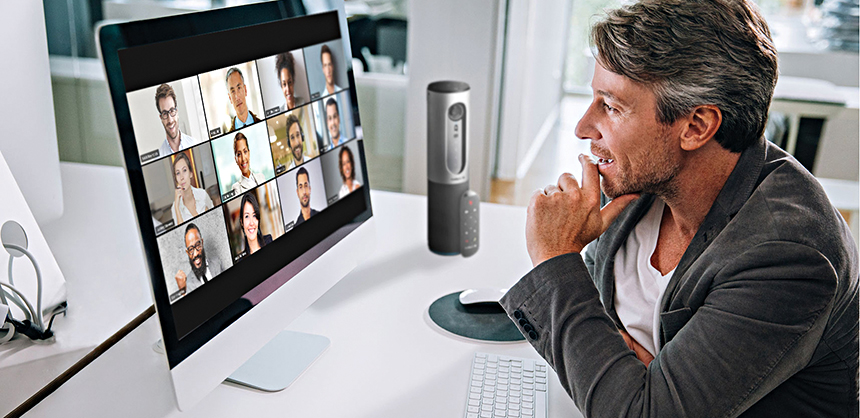Attendee Attention:July 13, 2020
As Meetings Go Virtual, Planners Must Devise Ways To Keep Attendees Engaged By Patrick SimmsAttendee Attention:
As Meetings Go Virtual, Planners Must Devise Ways To Keep Attendees Engaged
For the time being, conventions have gone virtual, and many association planners have had to “up their game” in designing and facilitating these events. As with face-to-face events, the goal is attendee engagement. Being restricted to a screen, the experience can never be as compelling as when attendees are surrounded by their peers at a convention center or hotel. But learning, networking and even entertainment can still take place. The primary ingredient, as always, is content that answers to members’ professional needs.
When the Society for Human Resource Management (SHRM) transitioned its Talent Conference & Exposition to virtual this past spring, organizers kept in mind that members value “learning programming and the ability to earn professional development credits for their recertification,” explains Angela Elder, vice president, events, SHRM.
They also value “being able to hear from thought leaders who address timely topics,” she says. The virtual version of the conference delivered on both counts. And while COVID-19 was not an overt focus, sessions did cover how the pandemic is impacting HR areas such as recruiting, onboarding and employee engagement.
Similarly, the 2020 National Association of Colleges and Employers (NACE) Conference + Expo, originally scheduled for June 2-5 in Minneapolis, Minnesota, was converted to a virtual meeting that included a focus on “new world challenges,” says Megan Ogden, CMP, director, meetings & events, NACE.
For example, the use of virtual platforms is growing in higher education, especially in the current circumstances, and one track in the program was devoted to that trend.
Some Familiarity Exists
Since most association members now are quite familiar with virtual education via webinars offered throughout the year, they will typically be able to adjust to a virtual version of the annual convention. What they may find more challenging is affording to participate, given the economic limitations many are facing.
“The challenge is to know when to start charging for content,” Ogden says. “A lot of associations immediately responded to members’ needs by offering free content, but we can’t fiscally operate for a full year offering free content.”
Ultimately, NACE members were able to view keynotes, exhibitor sessions and awards presentations free of charge, but the educational sessions came with a fee. “We decided to make things extremely cost effective for our members, whether they were able to pay on their own or have their institution pay,” she says. “Institutions in higher ed have budget freezes . . . potentially into next year. We also found that the majority of people who thought they could get approved for funding felt that any learning that would be approved had to be around COVID-19.”
Keeping the production of the event affordable for the association is also important, given the now-tightened budgets at many organizations.
“One of the big challenges is cost,” Ogden says. “There are a lot of amazing virtual platforms for meeting planners right now. We did go through an RFP process and, ultimately, we just couldn’t afford it [given] the unknown budget restrictions we might be facing this fiscal year.” As a result, NACE’s meeting was conducted via Zoom, which was suitable despite missing the virtual expo hall features and branding capabilities of more specialized platforms.
“I think the main challenge right now for organizations that have not done any virtual offerings is finding the right platform and partner,” Elder says. “A lot of the good ones are inundated with requests. Some are not even accepting new clients.”
While SHRM partners with ON24 for its webcasts, Digitell facilitated the association’s virtual Talent Conference. Elder highlights several advantages of the Digitell platform. “It is super important to our attendees to be able to interact with each other, and that [feature] is available on the Digitell platform while a presentation is going on. It was highly utilized by our audience,” she says. Attendees can submit questions to presenters, and presenters can conduct audience polls, after which the platform summarizes the results.
Zoom also has a Q&A capability, and the Society of Architectural Historians also found it a reasonable choice for the organization’s “first foray into the virtual world,” remarks Christopher Kirbabas, director of programs. “We liked how relatively easy it was to use from both the hosting and viewer perspective.
Using the Q&A feature was beneficial for both the session moderator and the attendee as so many more attendees could ask questions, and the session moderator could curate the questions so that every speaker had an opportunity to talk about their research.”

Chat rooms have become increasingly important tools for networking as meetings have gone virtual. Attendees generally report that they are satisfied with online meetings, but most report that they are eager for face-to-face events to return as soon as 2021. (Photo Courtesy of Zoom)
Get Presenters Ready Beforehand
Preparing presenters and session hosts, as needed, for the virtual delivery also helps to ensure an optimum experience for viewers. “We provided detailed step-by-step instructions to our session chairs and speakers on how to pre-record their presentation and also how to handle the live component of their session,” Kirbabas says. “It was two weeks of daily afternoon rehearsals to make sure we knew how to handle what needed to be done, but also how to handle any curve ball that might get thrown at you. We also asked each session chair and speaker to login to their Zoom session room 15 minutes prior to their session for introductions and a rundown of how the session will be run by the host. Our goal was to make the tech aspects as easy as possible for the session chairs and speakers.”
Similarly, Elder’s team coached presenters to make sure their sessions were successfully delivered. “We had a number of webcasts with presenters ahead of the event with our provider so they could understand the platform, and offered them some best practices, from the stability of your internet connection, how your camera should be placed, what your lighting should look like, etc.,” Elder says. “We found that our presenters were hugely receptive to all sorts of feedback, and we would even have presenters chiming in to help other presenters, and making sure they were comfortable.”
Prepping attendees themselves is equally helpful. “On each of the three days prior to the [virtual] event on June 25, we offered a prerecorded session,” says Patricia P. Olejnik, CED, associate director, experience planning & design, with the Association of Legal Administrators. “This gave our attendees and business partners additional education and an opportunity to learn how to log into and navigate the platform, to become comfortable with it.”
Ease of use doesn’t guarantee engagement, of course. Interactivity is considered the main way that attendees can take their virtual experience to the next level. The aforementioned Q&A and polling features are thus invaluable, and the host organization does well to encourage participants to utilize those functions. “We are asking each speaker to include some type of engagement through polling and Q&A, where questions will be ‘fed’ to the speaker from a chat room moderator, and any other means they have,” says Olejnik, whose association is partnering with ConferenceDirect for virtual meeting delivery. “Some are introducing and sharing a whitepaper, using video and audio embedded into their presentation, and including takeaways that can be utilized by the attendee back at the office.”
Limited Daily Content Maintains Focus
It’s also important to realize that many attendees cannot maintain a high engagement level for extended periods. There is also the “Zoom fatigue” syndrome that is setting in during the pandemic. “We know everybody’s fatigued with Zoom, so we’re offering all of the content over the course of about seven to eight days, and only about three hours of content for each day,” Ogden says. “We know people don’t want to sit down for a full day, so we’re hoping that by chunking the content up, it will give them more of a variety to pick and choose based on their schedule and their needs.” Zoom’s breakout capability, where groups can be split up, adds further flexibility to the session offerings.
Building respites into the virtual meeting agenda is also valuable, allowing attendees to recharge their batteries. “Because people are at home and maybe less likely to be moving around, we did breaks called Stretch & Connect, where we had a yoga teacher prerecord stretching demonstrations. Attendees loved it,” Elder says.
In the end, SHRM’s approach to engagement was vindicated via post-event analytics. Based on data about who has signed in and average length of time they’re signed on, the Digitell platform calculated an 84% engagement rate the first day, 81% the second day, and 74% the third day, which was a half day. Elder notes that the performance on the last day was better than the last day of the face-to-face event, when attendees are traveling home. On each day, “we had very little engagement drop off from the morning through the day,” she says. “Our platform provider told us that we started off strong. Our kickoff session was our CEO giving an update on the state of HR and talent. And then we had what we would call our keynote speakers. It was a series of three back-to-back TED Talk-style speakers who were addressing unconscious bias in the talent process. They were keynote level, so they had a certain charisma and gravitas.” As with an in-person convention, a virtual event benefits from immediately drawing attendees in by front-loading compelling presentations.
Along with timely content, networking is the other major value proposition of conventions, and virtual events should facilitate that as much as possible. Chat rooms are a traditional place for participants to connect. “We set up, at different points in the agenda, dedicated chat rooms for virtual networking, and it was super successful,” Elder says. “We have testimonials from attendees who said they felt like they networked with more people at this event than they had at in-person events.” The Digitell platform allows attendees to build a profile in the chat room or link to their LinkedIn page. “We also hosted virtual happy hours utilizing Zoom,” Elder adds.
In addition to chat rooms, Olejnik’s team is incorporating one-on-one video meetings and a program called Meetings of Minds. “The latter is a type of idea exchange, a roundtable, where up to 30 people per virtual room can interact and discuss a current topic during our Engagement Hour, in-between morning and afternoon education sessions,” she explains.
It may be argued that engagement is especially critical for virtual conventions since remote participants are susceptible to distractions. However, in today’s highly wired age, even in-person attendees can easily be distracted by their smartphones. Moreover, some attendees may actually find it quite easy to focus in a home or office environment. Among the positive feedback to NACE’s virtual conference, one attendee commented, “It’s been 10 years since my first NACE conference. I really loved the virtual experience as there were no distractions, plus the comfort of being in my own home,” Ogden says.
With the virtual conference exceeding NACE’s registration and sponsorship expectations, “I feel it’s going to influence us to do more hybrid events,” she says. “We’re hopeful that by next June that large gatherings will be able to be resumed but, given the unknown, we do think we’re going to have to offer more hybrid events. We will likely look for a different platform that has more features for networking and engagement” than Zoom.

Being restricted to a screen, virtual meetings can never be as compelling as when attendees are surrounded by their peers and networking at a convention center, hotel or other venue. But learning, networking and even entertainment can still take place when planners spend the time and put in the effort to come up with the right ideas to make a successful online event. (Photo Courtesy of Zoom)
Positive Attendee Feedback
The Society of Architectural Historians’ virtual conference was also a success, based on attendee feedback. “Ninety-two percent of our attendees felt that the virtual conference exceeded or met their expectations,” Kirbabas says. While that kind of feedback is strong evidence that attendees have maximized their virtual experience, it’s not a sign that they prefer virtual to face-to-face. Rather, the positive feedback simply indicates that members are receptive to a virtual or hybrid version of the annual convention. “While our virtual conference participants are eager to return to a face-to-face setting in 2021, 60% of them would participate in both a face-to-face and virtual/hybrid event,” Kirbabas says. “As such, we are planning to host our roundtable discussions online again next year, as attendance for them jumped dramatically this past May. We also are planning additional online programming throughout the year, as well as a virtual/hybrid component to next year’s conference in Montreal.”
Similarly, Elder says she expects that the success of SHRM’s virtual Talent Conference & Exposition this year “will definitely increase our usage of virtual in our events. In the short and long term, we are thinking and planning for hybrid events where you can sell both in-person and virtual passes.”
If there is an overall takeaway from the success of these virtual conventions for the planner tasked with designing them, it is the importance of diversifying the attendee experience. The virtual medium is often perceived as more “limited” compared to face-to-face. And short of the most advanced virtual reality technologies, the experiential limitations will always exist. But that doesn’t mean that a diverse experience can’t be created where attendees can learn, interact, see and hear each other, network, be entertained and even take guided wellness breaks, as Elder’s team scheduled for SHRM attendees. All of these activities parallel the in-person experience. “We offered a little something for everyone, based on what they would normally expect and gravitate to,” she concludes. “So, we were not only able to make the pivot [to a virtual convention], but have it work out.” | AC&F |








